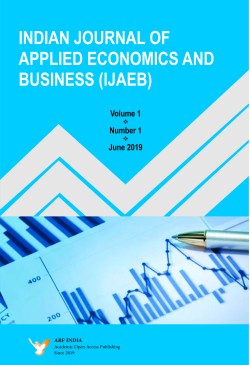
Indian Journal of Applied Economics and Business
Frequency :Bi-Annual
ISSN :2582-4325
Peer Reviewed Journal
Rural development in India is directly related to the nurturing of handicraft sector as its growth trend reflects the rural economy. The present research has been conducted in the tribal dominated Mayurbhanj district of Odisha, India as good many artisans in Mayurbhanj are engaged in making Sabai crafts which are having tremendous export potential. At present Sabai craft artisans are struggling to market their product due to many reasons. Artisans are mostly depending on the middlemen for selling of finished products because of their illiteracy and ignorance as a result those middlemen earns huge profit. Thus present research is an attempt to study the challenges that the artisans are facing in marketing Sabai crafts of Mayurbhanj in both within and outside the country.
Keywords: Sabai crafts, artisans, marketing challenges
The study investigated the influence of incentives and socioeconomic variables on investments of a random sample of 100 cooperative member-patrons distributed among 20 cooperative societies that were purposively selected for analysis based on the reliability of available data furnished by the societies. Regression technique was used to investigate the influence of socioeconomic and incentives on investment levels of cooperative members and to test statistical hypotheses in association with the t – statistic. Correlation analysis was used to determine relationships of socioeconomic factors with incentives. Results show that Returns on shares, and savings had highly significant (p<0.01) and positive influence on investments of the respondents. There was a negative and significant (p<0.05) relationship between age of respondents and investment amounts, younger members would invest higher than older cooperative members. Furthermore results indicated positive, significant (P<0.01) correlations between savings and returns on shares (r = 0.5108); Savings and Returns on savings (r = 0.5668), and Savings and Dividend (r = 0.8321). Total assets (savings plus value of investment in shares were positively, significantly (p<0.01) correlated with returns on shares (r = 0.81554), returns on savings (r= 0.4645), and dividend (r =0.9356). Improvement in provision of incentives to members according to socioeconomic factors would enhance higher investment for rural development.
Keywords: Investments, cooperative societies, incentives, socioeconomic factors.
Applying an extended IS-LM model, this paper finds that real depreciation raisedoutput during 1991-2006 whereas real appreciation increased output during 2007-2018. In addition, a higher government borrowing to GDP ratio, more real money supply, a higher stock price, a higher real oil price or a lower expected inflation tends to raiseoutput. The positive impact of real appreciation on output during 2007-2018suggests that its positive effects of lower domestic inflation or capital inflows outweigh its negative effect of less exports. These results suggest that either real depreciation or real appreciation may raiseoutput depending upon the stage of economic development.
Keywords: Real Depreciation or Appreciation, Fiscal Policy, Monetary Policy, Stock Prices, Oil Prices.
JEL Classification: F41, E62